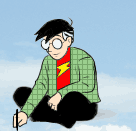In the comments to an earlier entry about formats and Lightbox 2, Chris Bolton links to a full screen version of the same approach that’s worth checking out as well.
Of course, this has precedents. Whatever you think of Zuda and their business model, I think they at least had their eyes on the ball when it came to design priorities. “Fit the screen/fill the screen” isn’t a bad way to go for page-to-page formats. Unlike strips, which can thrive in a terrarium of distractions, long form comics work best if all other distractions go away until the story is over. Sadly, both full screen modes seem to short-circuit keyboard commands, but we can’t have everything. (No wait. Screw that! Why can’t we?)
My dream “next page” button?: The spacebar.
Or better yet: Just tap and slide.
We’ll see.













